The Singur Smokescreen: - Part I
The coverage of the process of land acquisition in the mainstream English press obfuscates and falsifies ground realities.
Aniruddha Dutta
An anti-democratic press?
Much has been debated in the print media - through editorials, solicited op-ed pieces and readers� letters or website threads - about the macroeconomic issues connected with the acquisition of agricultural land for industry by the state, notably in the case of the Tata Motors small-car plant in Singur, West Bengal. Most of the mainstream English press (The Telegraph, Hindustan Times, The Times of India) has forwarded the conclusion that such land acquisition is necessary, attended by certain short-term problems and long-terms gains for all. This article will not go into the tenability of that conclusion, but highlight the way this same press has treated and covered the ground situation through the course of the Singur acquisition - from the protests in June/July, to the beginning of construction of the Tata factory in the third week of January. A detailed survey of this coverage shows that at least at the acquisition stage, sections of the press have not bothered to look into or advocate even a nominal democracy or justice during the acquisition process, and in fact, have often worked to unquestioningly support the lack of transparency and even the violation of rights�all in the great cause of development. Thus, there is not only a "disenfranchisement" of lower class sections from the media as Aloke Thakore has recently suggested in The Hoot, but also an inadequate scrutiny of government and police procedures, misrepresentation and suppression of dissenting voices, and the creation of a sense of panic around the infiltration of "outsiders" into the area, to effectively support anti-democratic restrictions on the expression of resistance.
The maximum damage to the cause of just representation and liberal debate would attach to the ABP (Anandabazar Patrika) group and its mouthpieces The Telegraph and Anandabazar Patrika, which went heavy duty in their support of the Government and condemnation of any opposition to its methods and policies. This went to the extent of supporting blanket use of force by the state to check "violence" in the area: without any real thorough enquiry into the causes and nature of resistance, without scrutinising whether the "threat" warranted unqualified use of state force, but evoking a rhetoric similar to the all-too-familiar "war against terror": "Violence has only one antidote: counter-violence. In this context, the actions of the police at Singur on Saturday had one major flaw. They were woefully inadequate." ("No velvet glove", TT December 05, 2006). In another editorial, the newspaper even justified the overall opaqueness and lack of dialogue with the affected people regarding the land acquisition process and policy, by holding up an abstract ideal of "best for west Bengal" that apparently justified any means taken: "Industrialization must take place and therefore land has to be obtained. How the land will be obtained � through consent or otherwise � is a matter of political management� it cannot be part of the government�s decision-making� (which) must be driven by what is Best for West Bengal" ( "Best for West Bengal", TT, Dec 24 2006). There are less blatant but more insidious cases of bias, for example when a national newspaper like The Times of India presents a skewed representation of public opinion in favour of the acquisition: the web edition carries a readerspeak thread titled "all sensible people are with Buddha", whereas a detailed perusal of the thread yields greater diversity and unevenness even among middle class voices.
The sections that follow will attempt to unravel in greater detail the many problems with the coverage in the most prominent English dailies in the East (The Hindu and Indian Express, having negligible market share, have been omitted). Even if one, hypothetically speaking, does not question the logic of land acquisition for industry and accepts the media conclusion that it would eventually be "best" for everyone, what gradually emerges is how the presentation of this logic uses exclusion, distortion and inadequate representation of the "people" as its premises. At the worst, some of the coverage (like The Telegraph) totally constricts the liberal democratic space for debate and dissent, obfuscates facts and ground realities, and in effect, works to violate the basic precepts of democracy itself. Then again, some of the coverage (like The Times of India) has been hypocritical in mouthing demands for greater transparency in editorials while often accepting government and corporate versions of the story in news reports that have a more immediate relevance and impact.
The questions of "consent" and willingness
The issue of "consent" has been presented as one of the most chequered ones in the controversy around Singur, with the media focusing on claims and counter-claims from the Government (through the "status report") and the Trinamul Congress (through affidavits presented to the Governor). The government, and even a CPM politburo member like Brinda Karat, claims that most of the land has been taken with the "consent" of the land-owners (see Karat�s article "Singur: Just the facts, please", The Hindu, December 13 2006). On the other hand, The Paschim Banga Khet Mazdur Samiti has refuted Karat�s claims point by point, in a piece available on the Web ("Brinda Karat�s Untruths", online at http://developmentdialogues.wordpress.com/the-singur-debate-articles-collected-by-samantak-das/). While the Trinamul Congress has presented a list to the Governor of plots that have been ostensibly acquired without consent, the government has claimed that 350 of the plots in the list are outside the acquired area. This expected political standoff has been projected as the main conflict in question by the English press, whereas other voices are less frequently accommodated: including the organisations directly comprising farmers. Let us examine two distinct areas where the issue of "consent" has been obfuscated, if not falsified, by the media or sections of the media.
The first area concerns the specific sense of "consent" within the procedure of land acquisition itself. It is not the purview of this article to go into the details of the claims and counter-claims on the area of plots and number of farmers� "consent" obtained. Rather, one notes the credence given to one party�s figures over the other (while not even considering or giving space to the claims of the farmers� groups), and the obfuscation of the details of the process: for example, the conflation of consent to compensation amount with consent for acquisition itself. While The Telegraph is largely guilty of the former, Hindustan Times effects the latter.
The appearance of the Government status report is greeted by The Telegraph with a front-page headline, "State picks 350 holes in Mamata Tata map" (TT, January 3, 2007). Each of the plots supposedly outside the fenced area is therefore rhetorically presented as decimating the Trinamul claim (there is no ground reporting to counter check the figures, even by way of a journalistic gesture.) We read, "Many of the plots Mamata Banerjee claims were forcible acquired from farmers in Singur are not part of the land earmarked for the Tata small car factory at all, the government has found". The government doesn�t �claim� or �state�, it finds: the newspaper thus gives complete credence to government report (in the same edition, Pg 13 carries a statistical graphic on land acquisition with "figures according to a government release" so that the claims are even more clearly and credibly presented to the reader). The front-page article gives no reference to other ground-based claims on forcible acquisition (e.g. those of the Paschim Bangla Khet Mazdur Samiti), which give far different figures regarding "consent". The opposition is thus generalised into the Trinamul, which having largely lost political credibility among the middle class in Bengal, is an easy straw doll to set up only to knock down. In this way, the government�s claims are made to appear unchallengeable, and the issue of force hidden from view.
However, there is one telling detail in the report that gives the deviousness of the game of representation away: it is a quote from Nirupam Sen, the state minister for industries. ""Under the Land Acquisition Act, there is no scope for individual consent to acquisition. The farmer can only give consent to the compensation amount he�s being offered," Sen explained". This crucial fact is completely ignored in the rest of the article, by focusing on the supposed falseness of Mamata�s claims.
The obfuscation of the definition of "consent", into apparently meaning more than it does, is very clear in the Hindustan Times article on the same date. In comparison to The Telegraph, which at least includes the clarification regarding consent, HT straightaway assumes "consent" to mean willingness to allow the acquisition of land: "A state report filed by the commerce and industries department� contradicts Mamata Banerjee�s claims that a big section of the Singur farmers is unwilling to give up their land" (HT, January 3, 2007). The headline for the article again carries out this extension of the concept of "consent": it states, "State figures to refute land grab claims", whereas if "consent" means only consent to compensation, the "land grab" doesn�t even come under its purview. What this article, like the article in The Telegraph, also conveniently ignores is the issue of non-landowning farmers: sharecroppers, landless labourers and so on. The Times of India doesn�t even carry the story, perhaps mercifully.
It is to be noted that the list of "consenting" farmers was not even put forth at this point - the list was eventually put up on the government website only on January 12, when The Telegraph carries no follow-up (having supported the government claims even before they are fully put forth). Only The Statesman (which, it must be noted, has a long anti-CPM record) carries an article scrutinising the list: "the controversy-dogged list of consent award for acquisition of land for the Tata small car project at Singur� leaves the crucial questions unanswered".
Otherwise, what we see is that instead of putting any real pressure on the government to come clear on facts or transparency, some major newspapers only make token gestures toward transparency while accepting and even exaggerating government claims�this is almost criminal given the stakes at the ground level.
But of course, the issue of "consent" hardly stops with the specific procedures for acquisition/compensation: the issue is expanded (by both the government and the media) into one of general willingness to the process of industrialisation itself. It is by now well known that the group of farmers is not a homogenous whole, but comprises land-owners, share croppers, landless labourers et al. The acquisition of land might have had different implications for, and different reactions from the land-owning and non-owning or share-cropper sections, and the analytical articles have repeatedly emphasised these disparities. This has not stopped a section of the media from building feel-good sense of a general willingness to the land acquisition and industrialisation process based on the opinions of few.
Perhaps the most blatant instance of this was the formatting of an article on Singur, "Fields of Foment", published in The Telegraph on December 10, 2006. The introduction to the article is seemingly dispassionate, balanced: "The �bargadars� are opposing the government that had given them a share of the land (while) �jotdars� have come to the CPM�s aid", reports Debashis Bhattacharyya. However, the large caption, spread across the top of the page in bold type, gives the politics of representation away. What we read is a quote; "We should get a picture of Ratan Tata and do his puja every day". This is a quote from a jotdar, happy that he can sell off his land. The article text contains other voices from bargadars who take a radically different point of view, but their voices are not highlighted to such a level. Moreover, the text of the article ignores the combined resistance of the poorer farmers in various subtle ways: "Singur, heaving with a political convulsion, has witnessed a sea-change ever since the Tatas picked it as the site for a small car plant". The problem with Singur is located as a problem of "political convulsion" involving the state and the opposition, and as a problem in rural sociology itself, involving "opposite extremes of the rural spectrum". What is left out is of course the sense of any real struggle; yes "foment", between the state and the police/RAF on one hand, and the poorer farmers and villagers on the other.
Another instance of the creation of a sense of feel-good is the commencement of the construction of the Tata factory in the third week of January, as covered by The Telegraph and The Times of India (the Hindustan Times did a better job this time with some ground-based probing). The Telegraph presents the construction not as an expected development but as an achievement, almost a triumph: the headline of the front page anchor reads, "Tatas Break Ground" (TT, Jan 21, 2007), with the caption saying "work begins in Singur with local role". The first sentence of the article creates the sense of a general willingness and effort: "About 100 Singur villagers drove the Tata Motor�s plant�s first three pillars into the ground as the "people�s car" project turned on ignition today" (note the strategic mention of the "people�s car" - who, of course, are these "people"?). Following this in the next paragraph, a farmer is quoted as saying that "I feel very happy, we never earned enough from farming". The juxtaposition of this quote with the first positive sentence of the article mentioning "about 100 Singur villagers" obviously connects the two to build a general picture of welcome opportunity. But one needs to cross-check with just one more report from the ground, this time in the Hindustan Times, to get a sense that there is no such uniform sense of satisfaction, while there indeed is widespread resentment and anxiety. The report "We shall all eat cars" (HT, Jan 21 2007), appearing one day before the Telegraph anchor, takes a brief survey of the opinions and behaviour of various villagers in the adjoining mouzas: ""I�ve invested in two minis [tubewells] and a tractor without asking for any government help," says Mahadeb Das. "Now, the government has put half of my land behind the fence insisting that I had agreed to sell those plots. Why would I want to sell land that provides me with better money than I can make out of a onetime payment?"� Binoy Das, a sharecropper asks with a wry smile, "It�s as if farming is suddenly a crime!"� "A Kolkata journalist recently asked me whether the farmer�s son should remain a farmer forever," says Dhana [a gram panchayat member]. "What is wrong with being a farmer?""
Thus, the ethics of representing farmers is a question from which The Telegraph cannot be exempt: in what context should a vulnerable section like the farmers be quoted? If a marginal farmer like Sanat Das says he is happy to have found better paying work, does it mean he and his likes are really well taken care of in the long term? Construction work is obviously a one-off job, can it compare in any way with loss of land-based occupation, even if not well paying? Ignoring the resistance of farmers and creating a false sense of general willingness has the gravest implications for the media as a forum of representation in a democratic society.
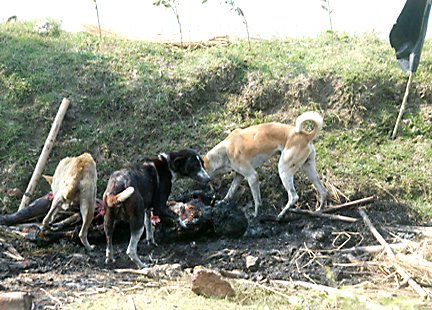

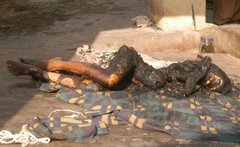
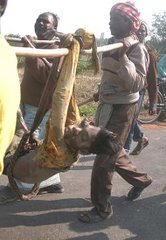
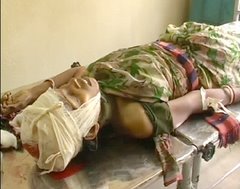

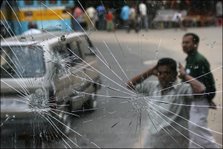
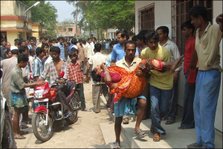




No comments:
Post a Comment